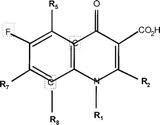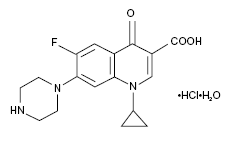Ciprofloxacin is a broad-spectrum synthetic fluoroquinolone antibiotic that is effective against both aerobic gram-positive and aerobic gram-negative bacteria[1].
Bacterial organisms that have been shown to be targeted by ciprofloxacin are:
Aerobic Gram-Positive Bacteria (With Certain Strain Particularities):
Enterococcus faecalis (many strains are only moderately susceptible), Staphylococcus aureus (methicillin-susceptible strains only), Staphylococcus epidermidis (methicillin-susceptible strains only), Staphylococcus saprophyticus, Streptococcus pneumoniae (penicillin-susceptible strains only), Streptococcus pyogenes.
Aerobic Gram-Negative Bacteria:
Campylobacter jejuni, Citrobacter diversus, Citrobacter freundii, Enterobacter cloacae, Escherichia coli, Haemophilus influenzae, Haemophilus parainfluenzae, Klebsiella pneumoniae, Moraxella catarrhalis, Morganella morganii, Neisseria gonorrhoeae, Proteus mirabilis, Proteus vulgaris, Providencia rettgeri, Providencia stuartii, Pseudomonas aeruginosa, Salmonella typhi, Serratia marcescens, Shigella boydii, Shigella dysenteriae, Shigella flexneri, Shigella sonnei.
Ciprofloxacin also exhibits in vitro minimum inhibitory concentrations of 1 μg/mL or less against strains of the following bacteria (with less adequate characterizations of the effects of treatment against these bacteria in terms of efficiency and general safety):
Aerobic Gram-Positive Bacteria (With Certain Strain Particularities):
Staphylococcus haemolyticus, Staphylococcus hominis, Streptococcus pneumoniae (penicillin-resistant strains only).
Aerobic Gram-Negative Bacteria:
Acinetobacter Iwoffi, Aeromonas hydrophila, Edwardsiella tarda, Enterobacter aerogenes, Klebsiella oxytoca, Vibrio cholerae, Legionella pneumophila, Vibrio parahaemolyticus, Pasteurella multocida, Vibrio vulnificus, Salmonella enteritidis, Yersinia enterocolitica.
Most anaerobic bacteria exhibit Ciprofloxacin resistance.
The effectiveness of Ciprofloxacin against the anthrax-causing bacteria, Bacillus anthracis has been demonstrated in vitro and by use of surrogate marker serum levels [2][3]. Thus, Ciprofloxacin, currently, is a Food and Drug Administration (FDA)-approved treatment for patients who have been exposed to anthrax via inhalation[4]. Likewise, Ciprofloxacin may be used to treat plague (from the bacterium, Yersinia pestis) and tularemia (from the bacterium, Francisella tularensis)[5]. Thus, Ciprofloxacin demonstrates usefulness in the field of counter-bioterrorism given its action against bacteria that, potentially, could be implemented in biological warfare. Furthermore, in its extended-release tablet form, Ciprofloxacin targets certain types of urological infectious agents (e.g. those causing epididymitis). The nature of Ciprofloxacin, then, as a powerful, broad-range antibiotic is crucial for broad-range bacterial infection treatment. An understanding of the action of Ciprofloxacin at the molecular level is necessary for an appreciation of the potency of Ciprofloxacin witnessed at the macro level.
Historical Information
Although the official patented introduction of Ciprofloxacin by Bayer Pharmaceuticals occurred in 1987, some reports indicate that at least two European patents for similar drugs pre-dated the Bayer patent by five years[6]. On October 27, 1987, the FDA approved the drug for use in the United States for the treatment of certain bacterial infections. The effectiveness of Ciprofloxacin as an antibiotic went unchallenged by all alternative antibiotics[7]. Consequently, other pharmaceutical companies were forced to offer their alternative antibiotics at lower costs (compared to the cost of Ciprofloxacin) so as to engage any sort of competition with Bayer Pharmaceuticals. Because of the increasingly common tendency of physicians to prescribe lower-cost medication, Bayer Pharmaceuticals could not expand into the international pharmaceutical market (which, as a whole, was declining) and, consequently, was forced to downsize at the turn of the century. Thus, the competitive effectiveness of Ciprofloxacin did not overcome the competitive pricing of drugs released by other pharmaceutical companies. Faced with the impending expiration of its patent for Ciprofloxacin in the early years of the millennium, Bayer Pharmaceuticals attempted to release variations of Ciprofloxacin. The release of Ciprofloxacin variations such as Pediatric Ciprofloxacin and Once-daily Ciprofloxacin allowed for the extension of the Ciprofloxacin patent. The popularity of Ciprofloxacin rose sharply after September 11, 2001 due to its characteristic targeting of Bacillus anthracis, which was projected as a means of bioterrorism. The prescription of Ciprofloxacin for treatment of bacterial infections continues to this day.
Structure and Administration
General Quinolone-Fluoroquinolone Structure
Ciprofloxacin is identified as a "quinolone" because of its heterocyclic (with an inner-ring Nitrogen), bicyclic core-containing structure. This structure is characteristic of all quinolones[8]. Specifically, Ciprofloxacin is characterized as a "fluoroquinolone" since it contains a fluorine atom at the R6 position of its bicyclic core[9]. All fluoroquinolones contain this R6 fluorine moiety. A general molecular structure for all fluoroquinolones is shown. The R6 fluorine occurs on the left ring of the bicyclic core.
 [10]
[10]
Atomic Structure
The specific atomic structure of Ciprofloxacin is shown (all atoms are labeled and numbered).
Administration
Usually, Ciprofloxacin is administered either as CIPRO® Oral Suspension (Ciprofloxacin), or as CIPRO® Tablets (Ciprofloxacin hydrochloride)[11]. Both administration types are oral.
CIPRO® Oral Suspension (Ciprofloxacin) is a 1-cyclopropyl-6-floro-1,4-dihydro-4-oxo-7-(1-piperazinyl)-3-quinolinecarboxylic acid with empirical formula: C₁₇H₁₈FN₃O₃. Ciprofloxacin has a molecular weight of 331.35 g/mol and occurs as a yellowish, crystalline substance[12][13]. A simple molecular structure of Ciprofloxacin is shown (base empirical formula).
 [14]
[14]
CIPRO® Tablet[s] (Ciprofloxacin hydrochloride) is the monohydrochloride monohydrate salt of 1-cyclopropyl-6-floro-1,4-dihydro-4-oxo-7-(1-piperazinyl)-3-quinolinecarboxylic acid with empirical formula C₁₇H₁₈FN₃O₃•HCl•H₂O. Ciprofloxacin hydrochloride has a molecular weight of 385.5 g/mol and also occurs as a yellowish, crystalline substance[15]. A simple molecular structure of Ciprofloxacin hydrochloride is shown.
 [16]
[16]
Ciprofloxacin also may be administered intravenously and in the form of eye drops or ear drops[17].
Synthesis
A six-step pathway for Ciprofloxacin synthesis is shown below.[18] This particular pathway is characterized by the initiation of a cyclic chloro-fluoro precursor followed by closing of a nitrogen-containing ring and addition of piperazine ortho with respect to the R6 fluorine. It should be noted, however, that other systems for Ciprofloxacin synthesis have been postulated.
Characteristic Protein Targets and Interactions
Ciprofloxacin is known for its efficient ability to hinder bacterial DNA synthesis via inhibition of bacterial DNA Gyrase and DNA Topoisomerase IV. [19]. DNA Gyrase, a type II DNA topoisomerase, is a tetramer composed of 2 GyrA subunits and 2 GyrB subunits. DNA Gyrase is responsible for introducing negative superhelical twists - as it removes positive superhelical twists - without which twists DNA Replication would not occur. Topoisomerase IV, also a type II DNA topoisomerase, is composed of 2 ParC subunits and 2 ParE subunits, and its overall structure is similar to that of DNA Gyrase. Specifically, ParC is homologous to GyrA, and ParE is homologous to GyrB. Topoisomerase IV is responsible for the separation of interlinked daughter chromosomes for the ultimate segregation of daughter cells. The action of Ciprofloxacin on DNA Gyrase and on Topoisomerase IV is characterized by the stabilization of DNA in complex with either of these two proteins. This stabilization prevents normal motility (and, thus, progression) of the DNA replication fork. This prevention leads to a full inhibition of DNA replication and, ultimately, to cell death.
DNA Gyrase Target
A twinned structure of is shown. DNA Gyrase is characterized by its "ironing device" appearance with a (in this scene, DNA Gyrase is light blue, and the dip-like cleft runs the length of the base of the protein; the DNA ligand is black and Ciprofloxacin, as in all scenes under this heading, maintains its atomic color labels). Ciprofloxacin intercalates on DNA at (in this scence, DNA is light brown and is in ball-and-stick formation). Ciprofloxacin inhibits the progression of DNA Gyrase on DNA by attacking and stabilizing successive coils of DNA for (in this scene DNA is in mesh formation). The effect of this intercalation on the specific base pairs of participating nucleotides is shown .This intercalation and consequent stabilization prevents proper unwinding of DNA by DNA Gyrase. An example of specifically interrupted sites on the DNA strand is shown . The precise mechanism by which Ciprofloxacin interaction with DNA Gyrase ultimately leads to cell death has not been elaborated fully. However, examination of the location of intercalation of Ciprofloxacin with respect to the amino acid residues of DNA Gyrase near this location leads to the observation that the characteristically polar atoms within the structure of Ciprofloxacin (i.e. fluorine, oxygen, nitrogen) seem to interact with the (in this scene, all polar amino acid residues are blue). A broader analysis indicates that this location, the active site of the protein, is composed, primarily, of (in this scene, alpha helices are purple, beta sheets and turns are brown for comparison; DNA is portrayed in dot formation, and Ciprofloxacin is not shown).
Topoisomerase IV Target
The structural characterization of the inhibition of DNA replication via inhibition of the action of DNA Topoisomerase IV by Ciprofloxacin is similar to that via inhibition of the action of DNA Gyrase by Ciprofloxacin. An example structure of is shown (note that this ligand is not Ciprofloxacin, but represents a structure that is analogous to that of Ciprofloxacin). The overall structure of DNA Topoisomerase IV is analogous to that of DNA Gyrase since DNA Topoisomerase IV also appears in an "ironing device" shape with a (in this scene, DNA Topoisomerase IV is light blue, and the dip-like cleft runs the length of the base of the protein; the DNA ligand is black and the example Ciprofloxacin structural analog, as in all scenes under this heading, maintains its atomic color labels). The ligand depicted here intercalates within the DNA structure slightly more aggressively compared to Ciprofloxacin within its DNA Gyrase target (see above), since the DNA structure in this case is (in this scene, DNA is in mesh formation). Yet the concept of obstruction of DNA motility via intercalation applies equivalently in this case and, thus, this model is sufficient for the action of Ciprofloxacin on DNA within DNA Topoisomerase IV. As expected, based on the aforementioned structural similarities, the interactions between the intercalating ligand and the active site of DNA Topoisomerase IV are similar to those witnessed between Ciprofloxacin and DNA Gyrase. The active site of the protein is composed, primarily, of (in this scene, alpha helices are purple and polar amino acids on these alpha helices are blue).
Efflux Pump Interaction
Certain bacteria (Escherichia coli, for example) contain a proton motive force-dependent multidrug , which, as the name suggests, grants the bacteria resistance to certain drugs [20]. In Escherichia coli, the efflux system that confers drug resistance is a tripartite transmembrane resistance structure known as "AcrAB-TolC" [21]. The drug molecule targeted for excretion is captured by the AcrB subunit (most likely from the periplasm or from the periplasm-intermembrane interface) and is then passed on to the TolC complex for final export. Of course, one could argue that the most important member of the AcrAB-TolC resistance complex is the member that is responsible for the initial attraction of the target compound, the AcrB subunit. Ciprofloxacin may be for removal from the bacterial cell (in this scene, AcrB is in the proposed transmembrane orientation assuming lower cytosolic face and upper exoplasmic face). It has been shown that contribute to the effectiveness of the initial affinity of AcrB for all targets [22] (in this scene, both Phe residues are magenta). It also has been shown that, after ligand binding, a proton may bind to an acidic residue in the transmembrane domain, which contains a, as yet, putative network of electrostatically interacting residues, the perturbation of which interacting residues leads to a series of conformational changes that result in drug expulsion. Some residues involved in this chain of events are , and (red, purple, green, respectively). The precise mechanism of the action of the AcrB efflux subunit (and of the tripartite AcrAB-TolC in general) is still under scrutiny.
Conclusion
As indicated in the explanation of the interaction between Ciprofloxacin and DNA Gyrase, the precise mechanisms of all Ciprofloxacin interactions and transport systems have not been elaborated completely. However, relevant research, particularly for insight on the precise mechanism for AcrB drug efflux, is underway. Regardless, it is clear that the action of Ciprofloxacin in vivo is important for the treatment of bacterial infections. The action of Ciprofloxacin on protein function seems to provide an avenue of research that could lead to new insights on mechanisms for protein function in general. Thus, Ciprofloxacin is a compound of interest in anticipation of a greater understanding of molecular functions.




